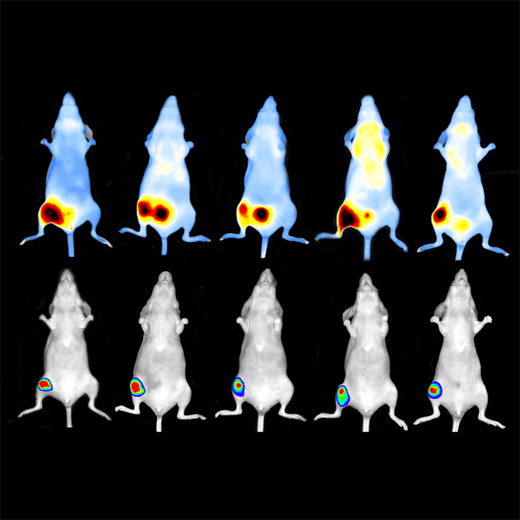
IVIS Lumina S5 Imaging System





IVIS Lumina S5 Imaging System





IVIS Lumina S5 Imaging System





The IVIS™ Lumina S5 high-throughput 2D optical imaging system combines high-sensitivity bioluminescence and fluorescence in a benchtop format. With an expanded 5 mouse (or 10 mouse imaging using optional manifold) field of view for 2D optical imaging plus our unique line of accessories to accelerate setup and labeling, it has never been easier or faster to get robust data- and answers- on anatomical and molecular aspects of disease.
Loading...
Product information
Overview
The IVIS Lumina S5 in vivo imaging system has all the capabilities of the current IVIS Lumina platform with improved throughput and accessories to streamline imaging workflow, data acquisition and analysis, ideal for accelerating your research.
High-throughput High-Sensitivity Optical Imaging
The IVIS Lumina S5 integrates a next generation 1 inch CCD camera into our benchtop instrument providing a high throughput 20 x 20 cm Field of View (FOV) sufficient for imaging 5 animals at a time for bioluminescence and fluorescence in vivo imaging.
As with other IVIS Lumina in vivo optical imaging systems, the IVIS Lumina S5 is equipped with 26 filters tunable to image fluorescent sources that emit from green to near-infrared. Novel illumination technology effectively increases fluorescent transmission through 900 nm. Moreover, the IVIS Lumina S5 incorporate Revvity's patented Compute Pure Spectrum (CPS) algorithm for spectral library generation software tools to ensure accurate autofluorescence removal, unmixing and fluorophore quantitation. Standard on all IVIS instruments, absolute calibration affords consistent and reproducible results independent of magnification, filter selection from one instrument to any another IVIS instrument within an organization or around the world.
IVIS Lumina S5 – A High Throughput Solution
Not only does the IVIS Lumina S5 offer higher throughput via the 1 inch CCD, but it is also compatible with a set of smart animal handling accessories (purchased separately) designed with throughput and safety in mind.
Smart loading trays allows users to pose animals on the benchtop before placing the tray into the IVIS. Fiducials built into the tray enable the software to automatically recognize and draw ROIs providing automated animal identification.
Animal trays are designed with ease of use and user safety in mind. No nose cones are required thus minimizing cleanup. When used with the next generation anesthesia unit (RAS-4), strong vacuum capabilities minimize excess gas from escaping thus preventing exposure of users to anesthetic gas.
Finally, Living Image™ software brings IVIS technology to life by facilitating an intuitive workflow for in vivo optical image acquisition, analysis and data organization. The software’s design creates an intuitive, seamless workflow for researchers of all skill levels.
Key Features:
- High throughput (5 mice) optical imaging
- Increased throughput (10 mice) using optional manifold
- Supports mouse and rat imaging
- Compute Pure Spectrum (CPS) spectral unmixing
- Full fluorescence tunability through the NIR spectrum
- Unique accessories to speed acquisition and analysis
- Small footprint–sits on your benchtop
- Complimentary Living Image software licenses are provided with the IVIS systems and upon request.
Specifications
| Dimensions | 48.26 cm (W) x 106.68 cm (H) |
|---|
| Brand |
IVIS
|
|---|---|
| Imaging Modality |
2D Bioluminescence
2D Fluorescence
|
| Unit Size |
1 unit
|
Video gallery

IVIS Lumina S5 Imaging System

IVIS Lumina S5 Imaging System

References
- Fichman et al (2021). Plasmodesmata-localized proteins and ROS orchestrate light-induced rapid systemic signaling in Arabidopsis. Science Signalling. 14(671). https://doi.org/10.1126/scisignal.abf0322
- Zhuang et al (2020). mRNA Vaccines Encoding the HA Protein of Influenza A H1N1 Virus Delivered by Cationic Lipid Nanoparticles Induce Protective Immune Responses in Mice. Vaccines (Basel). 8(1). https://www.ncbi.nlm.nih.gov/pmc/articles/PMC7157730/
- Fink et al (2020). Loss of Ing3 Expression Results in Growth Retardation and Embryonic Death. Cancers. 12(1). https://www.mdpi.com/2072-6694/12/1/80#
- Shong et al (2020). Serotonin Regulates De Novo Lipogenesis in Adipose Tissues through Serotonin Receptor 2A. Endocrinology & Metabolism. 35(2): 470-479. https://doi.org/10.3803/EnM.2020.35.2.470
- Fink et al (2019). Capacity of the medullary cavity of tibia and femur for intra-bone marrow transplantation in mice. PLOS ONE. https://doi.org/10.1371/journal.pone.0224576
- Zhao et al (2018). Hyaluronic Acid Layer-By-Layer (LbL) Nanoparticles for Synergistic Chemo-Phototherapy. Pharmaceutical Res. 35(196). https://doi.org/10.1007/s11095-018-2480-8
Resources
Are you looking for resources, click on the resource type to explore further.
Non-alcoholic fatty liver disease (NAFLD) describes a progressive pathology that affects the liver. Fat accumulation causes fatty...
Instrument background occurs when excitation light leaks through the emission filter. This occurs more frequently when the...
Scientists continue to explore several options to treat SARS-CoV-2 infection with hundreds of therapeutics at various phases of...
We recently spoke to researchers based at the Centre for Advanced Imaging at the University of Queensland in Australia who have...
This tech note outlines procedures on using auto-exposure on the IVIS® preclinical optical imaging platform using Living Image®...
Loading...
Loading...


How can we help you?
We are here to answer your questions.






























